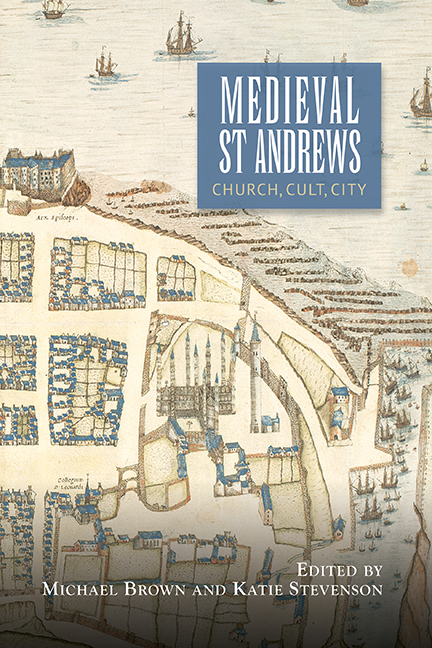Book contents
- Frontmatter
- Dedication
- Contents
- List of Illustrations, Charts and Tables
- Contributors
- Abbreviations
- 1 ‘Ancient Magnificence’: St Andrews in the Middle Ages: An Introduction
- 2 From Cinrigh Monai to Civitas Sancti Andree: A Star is Born
- 3 The Idea of St Andrews as the Second Rome Made Manifest
- 4 The Medieval Ecclesiastical Architecture of St Andrews as a Channel for the Introduction of New Ideas
- 5 When the Miracles Ceased: Shrine and Cult Management at St Andrews and Scottish Cathedrals in the Later Middle Ages
- 6 Religion, Ritual and the Rhythm of the Year in Later Medieval St Andrews
- 7 Living in the Late Medieval Town of St Andrews
- 8 The Burgh of St Andrews and its Inhabitants before the Wars of Independence
- 9 The Archaeology of Medieval St Andrews
- 10 Prelates, Citizens and Landed Folk: St Andrews as a Centre of Lordship in the Late Middle Ages
- 11 Augmenting Rentals: The Expansion of Church Property in St Andrews, c. 1400–1560
- 12 The Prehistory of the University of St Andrews
- 13 University, City and Society
- 14 The Medieval Maces of the University of St Andrews
- 15 Heresy, Inquisition and Late Medieval St Andrews
- Appendix 1 The St Andrews Foundation Account
- Appendix 2 The Augustinian' Account
- Appendix 3 The Boar' Raik
- Appendix 4 University of St Andrews Library, UYSL 110/6/4
- Index
- Miscellaneous Endmatter
Appendix 3 - The Boar' Raik
Published online by Cambridge University Press: 28 April 2017
- Frontmatter
- Dedication
- Contents
- List of Illustrations, Charts and Tables
- Contributors
- Abbreviations
- 1 ‘Ancient Magnificence’: St Andrews in the Middle Ages: An Introduction
- 2 From Cinrigh Monai to Civitas Sancti Andree: A Star is Born
- 3 The Idea of St Andrews as the Second Rome Made Manifest
- 4 The Medieval Ecclesiastical Architecture of St Andrews as a Channel for the Introduction of New Ideas
- 5 When the Miracles Ceased: Shrine and Cult Management at St Andrews and Scottish Cathedrals in the Later Middle Ages
- 6 Religion, Ritual and the Rhythm of the Year in Later Medieval St Andrews
- 7 Living in the Late Medieval Town of St Andrews
- 8 The Burgh of St Andrews and its Inhabitants before the Wars of Independence
- 9 The Archaeology of Medieval St Andrews
- 10 Prelates, Citizens and Landed Folk: St Andrews as a Centre of Lordship in the Late Middle Ages
- 11 Augmenting Rentals: The Expansion of Church Property in St Andrews, c. 1400–1560
- 12 The Prehistory of the University of St Andrews
- 13 University, City and Society
- 14 The Medieval Maces of the University of St Andrews
- 15 Heresy, Inquisition and Late Medieval St Andrews
- Appendix 1 The St Andrews Foundation Account
- Appendix 2 The Augustinian' Account
- Appendix 3 The Boar' Raik
- Appendix 4 University of St Andrews Library, UYSL 110/6/4
- Index
- Miscellaneous Endmatter
Summary
MEANING ‘the boar's run or range’, the Boar's Raik was the name applied to a large tract of lands in east Fife which from an early date supported church life and organisation at St Andrews. Its early forms include the following: Cursus Apri c.1140×50 AA §3, §7 [18th c.; see Appendix 2 for full context]; infra Cursum Apri 1212 St A. Liber, p. 315 [lands belonging to the archdeanery of St Andrews outwith the burgh of St Andrews within the Boar's Raik acquired by St Andrews Priory]; carrucate terre infra Cursum Apri c.1220 Terrier C [in the hands of the bishop of St Andrews; see PNF, iii, pp. 617, 619 and n. 39]; infra Cursum Apri 1309 Black Book of St Andrews, fo. xxxiv r; the Baris Raik c.1420 Chron. Wyntoun, iv, 374, 390.
According to the Augustinian's Account (AA), probably written in the 1140s by Robert, the first prior of the Augustinian Priory of St Andrews (see Appendix 2), the Boar's Raik was originally given to the church of St Andrews at its foundation by King Hungus, and restored by Alexander I ‘with the indisputable purpose and understanding that a religious society should be established in that church for the maintenance of divine worship’ (AA §3). The Augustinian's Account also states that this grant was re-activated by David I when the Augustinian house at St Andrews, founded in 1140, was languishing through lack of funds, cleverly emphasising the fact that the Boar's Raik was not part of the bishop's lands, and could therefore be diverted to the Augustinians without in any way diminishing the bishop's estates (AA §7). M. O. Anderson suggests that the bishop may have held the lands of the Boar's Raik not as bishop but as the representative of the old abbots.From the careful wording of Bishop Robert's 1140 foundation charter for the Augustinian priory (St A. Liber, p. 123) it would seem that the list of seventeen lands (eighteen if we assume that Balgove has been omitted in error) and two mills which are grouped together at the start of the bishop's grant represent the lands of the Boar's Raik, although that designation is not used.
- Type
- Chapter
- Information
- Medieval St AndrewsChurch, Cult, City, pp. 380 - 383Publisher: Boydell & BrewerPrint publication year: 2017



